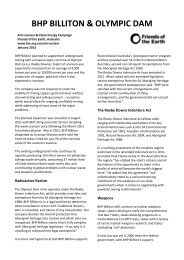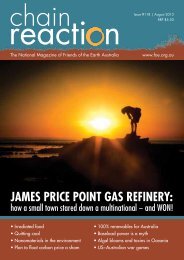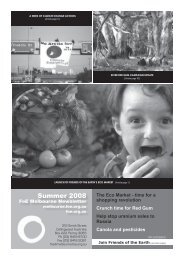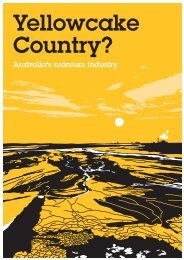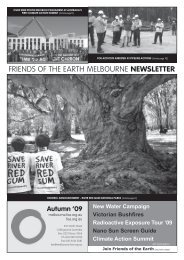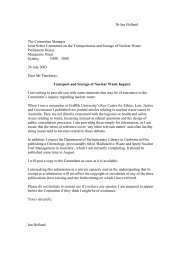Thirty Years of Creative Resistance - Friends of the Earth Australia
Thirty Years of Creative Resistance - Friends of the Earth Australia
Thirty Years of Creative Resistance - Friends of the Earth Australia
Create successful ePaper yourself
Turn your PDF publications into a flip-book with our unique Google optimized e-Paper software.
Since at least <strong>the</strong> early 1980s, FoEM has<br />
also run a bookshop, which continues to<br />
act as a high pr<strong>of</strong>ile street level presence<br />
for FoEM in its local community and is an<br />
important outlet for campaign materials<br />
and ideas. The FoEM bookshop is an<br />
important source <strong>of</strong> specialist books and<br />
materials. It has also helped to shape how<br />
o<strong>the</strong>r bookshops, libraries and institutions<br />
approach and portray environmental<br />
issues and concerns.<br />
FoEM ran a community arts space/<br />
gallery during <strong>the</strong> 1980s and early<br />
1990s, providing an early and important<br />
Melbourne outlet for indigenous artwork<br />
from central <strong>Australia</strong> and <strong>the</strong> Kimberley.<br />
This was an accessible and welcoming<br />
venue for local artists and o<strong>the</strong>r community<br />
ventures, and <strong>the</strong> FoEM building – <strong>the</strong>n<br />
at 222 Brunswick Street, Fitzroy – was a<br />
prominent part <strong>of</strong> Melbourne’s activist and<br />
cultural landscape.<br />
Following a campaign against French<br />
nuclear tests in <strong>the</strong> Pacific, <strong>the</strong> Anti-<br />
Uranium Collective emerged in 1974. Its<br />
aim was to oppose <strong>Australia</strong>’s contribution<br />
to <strong>the</strong> nuclear fuel/weapons cycle: <strong>the</strong><br />
mining and export <strong>of</strong> uranium. It now has<br />
30 years <strong>of</strong> continuous campaigning to its<br />
credit and continues to form <strong>the</strong> core <strong>of</strong><br />
FoEA’s national campaign activity.<br />
In <strong>the</strong> early days, various people had<br />
considerable influence on how <strong>the</strong> group<br />
developed. A number <strong>of</strong> members <strong>of</strong><br />
<strong>the</strong> Hayes family were significant and<br />
provided a strong tactical analysis <strong>of</strong> <strong>the</strong><br />
role <strong>of</strong> FoEM in <strong>the</strong> broader environment<br />
movement. Neil Barrett, Richard Nankin<br />
and Alison Parkes were involved in Chain<br />
Reaction magazine, which was based<br />
in <strong>the</strong> Melbourne <strong>of</strong>fice. Denis Hayes,<br />
Jim Falk and Neil Barrett collaborated<br />
on <strong>the</strong> production <strong>of</strong> <strong>the</strong> book Red Light<br />
for Yellowcake, which sold over 35,000<br />
copies. The ‘stop uranium mining’ stickers<br />
that were perhaps <strong>the</strong> quintessential<br />
slogan <strong>of</strong> <strong>the</strong> decade eventually sold<br />
more than 100,000. Les Dalton and Alison<br />
Parkes helped establish <strong>the</strong> Movement<br />
Against Uranium Mining (MAUM), while<br />
o<strong>the</strong>rs initiated <strong>the</strong> first ethical shareholder<br />
...................................................................................................................................................................................................<br />
actions at <strong>the</strong> AGMs <strong>of</strong> mining companies<br />
MIM and Hamersley. Andrew Herrington<br />
was actively involved, especially in <strong>the</strong><br />
development <strong>of</strong> <strong>the</strong> structure <strong>of</strong> <strong>the</strong><br />
organisation. Alan Parker, Mick Harris<br />
and Jack Gildering were among those<br />
who pulled <strong>the</strong> Alternate Technology<br />
Association (ATA) toge<strong>the</strong>r. Various bike<br />
related projects also worked from FoEM.<br />
In 1976, The Age newspaper described<br />
<strong>the</strong> FoEM <strong>of</strong>fice as a “barely furnished<br />
terrace house in Carlton … <strong>the</strong>re is no<br />
obvious indication that FoEM lives in at<br />
least 16 o<strong>the</strong>r countries, is represented on<br />
<strong>the</strong> UN Environment Program, and … has<br />
so far gained support <strong>of</strong> not just <strong>the</strong> left<br />
wing unions but pr<strong>of</strong>essional organisations<br />
and church groups … <strong>the</strong> <strong>of</strong>fice workers<br />
are fairly young, well educated and poor”.<br />
In <strong>the</strong> early 1980s, FoEM established<br />
a Food Justice Centre to work on plant<br />
variety rights at a time when patenting <strong>of</strong><br />
seeds began to pose a grave threat to<br />
subsistence farmers around <strong>the</strong> world.<br />
Its o<strong>the</strong>r concerns included <strong>the</strong> use <strong>of</strong><br />
harmful chemicals in Sou<strong>the</strong>rn nations<br />
and corporate ownership and control <strong>of</strong><br />
food. The creation <strong>of</strong> <strong>the</strong> Food Justice<br />
Centre marked a significant development<br />
in <strong>Australia</strong>n environmental politics. Its<br />
emphasis on international solidarity,<br />
critiques <strong>of</strong> corporate power, and cross<br />
over into areas far beyond ‘conventional’<br />
environmentalism was a living example <strong>of</strong><br />
FoEM’s style <strong>of</strong> work. In 1983, <strong>the</strong> Food<br />
Justice Centre established an organic fruit<br />
and vegetable co-op that ran for about<br />
six years. The co-op aimed to provide<br />
organically grown food at reasonable<br />
prices, to improve <strong>the</strong> network between<br />
growers, distributors and consumers<br />
<strong>of</strong> organic foods, to work as part <strong>of</strong><br />
<strong>the</strong> international campaign against <strong>the</strong><br />
use <strong>of</strong> pesticides in agriculture and to<br />
produce materials about methods <strong>of</strong> food<br />
production and <strong>the</strong>ir impacts on both <strong>the</strong><br />
environment and health.<br />
From <strong>the</strong> 1980s, FoEM consistently<br />
worked to highlight <strong>the</strong> risks associated<br />
with <strong>the</strong> release <strong>of</strong> genetically modified<br />
organisms (GMOs). In 1995, it published<br />
Gyorgy Scrinis’ book Colonising <strong>the</strong> Seed:<br />
FoE 30 <strong>Years</strong> 106



